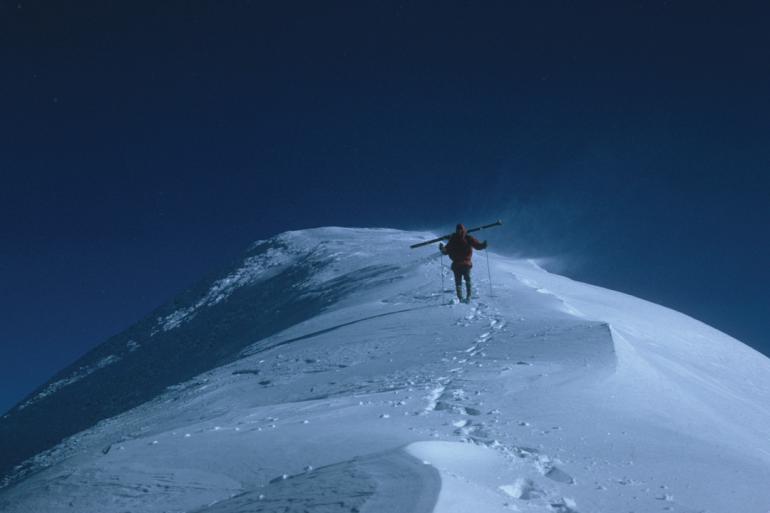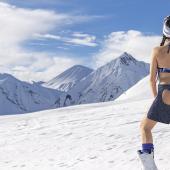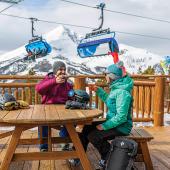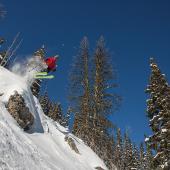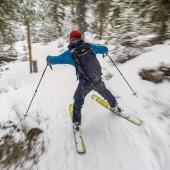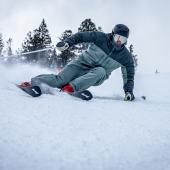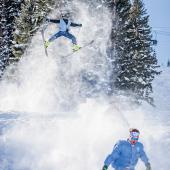Up and Over Lone Mountain
On a Friday morning in early February, 1971, George Claggett called up from Bozeman, just over the hill from where I lived in Ennis, to inform me that we were getting too fat from sitting behind our desks all winter and it was time to go on a trip. Fine, I said, and proposed a ski trip from the Gallatin River to the Madison. We could even summit Lone Mountain on the way through, taking a look at Chet Huntley’s proposed 20-million-dollar development before the people, chairlifts, and everything else crowded up Big Sky. George agreed, saying he’d bring the food, I’d bring the backpacking stove, and we’d meet at 4:45 the next morning at Four Corners. That’s all the organization two old-timers need for any trip. (If you hang out with someone long enough, you can predict what the other guy is going to forget.)
The night before the trip, the wind howled and the snow fell. Under these circumstances, I always wonder if a sane person would call off the trip—or what percentage of the population would even consider heading for the mountains in the first place. Being optimistic, I was sure nothing but blue sky would show up for our start at daybreak. The next morning at Four Corners, George joined my wife and me and we headed up the Gallatin in a dark snowstorm. That slick rear tire on my old Dodge station wagon kept making the nose point off the side of the road towards that black, rapid-studded stream, and we started to ponder the wisdom of heading for the high country.

As we got ready to chain up, the snow stopped and mysteriously the road cleared. We turned up the West Fork of the Gallatin and made it as far as the North Fork of the West Fork of the West Gallatin. (The folks responsible for naming creeks in that county sure had imagination.)
We unloaded in the dark, I kissed my wife goodbye, telling her we would call her from a ranch 25 miles over the mountains when we got there.
I had my army-surplus cross-country skis waxed up for cold fresh powder, and George put army-surplus skins on his old Heads with Rami Securis bindings. My bindings and footgear were somewhat unorthodox: I used those rubber-bottomed, leather-topped boots with felt liners topped off with bear-trap bindings. The boots were flexible enough to pop out when they should, they cost less than $30, stay warm and dry, and they’re easy to put on in the morning. And it wasn’t just because I was cheap, either. The leather-topped boots allow your foot perspiration to evaporate, keeping your feet much dryer than all-rubber boots.
As light broke, the clouds started to disperse. Glowing in the morning sun, there was the spotlighted peak reaching into the sky, forcing us to tilt our heads back just to take the whole thing in. We dove into our packs for the cameras and started snapping frames before the storm closed back in around the mountain.
We came to a weather station measuring stats pertinent to the proposed Big Sky Ski area. With five feet of powder burying it in, the recording thermometer showed zero degrees and falling. The clouds disappeared and we knew a cold, clear high was locking in.

We left the snowmobile tracks and headed up to the naked Lone Mountain, its 11,150 feet towering up between the Spanish Peaks Wilderness Area and the Hilgard Peaks, which were being studied for possible inclusion in a Wilderness. As we started up through the lodgepole pine forests, we wondered which of the white, red, blue, and yellow ribbons were road locations, which were lift tower locations, and which were home lot corners. We knew our kids would never know this wilderness and we savored what would soon be gone.
As the angle of the slope increased, we moved into Engleman Spruce forests. By noon, we were into the Limber Pine woods and we mused about how many people knew there were such kinds of trees—evergreens that branched out like maples and formed unbelievable shapes. They’re beautiful trees—my favorite because they can grow and thrive in this rugged alpine country.
At timberline, we found ourselves at the East Ridge of Lone Mountain. Peaks around here weren’t rated for difficulty because there wasn’t any demand for ratings—barely anyone had climbed the damn things. We knew Lone Mountain was a walk-up and no one ever mentioned it being difficult, so we just decided to take the East Ridge as a matter of convenience.

The wind howled over the ridge, just like it does to this day. We loaded the skis onto our packs and started hiking. The ridge’s snow formed a knife blade and the cornices became tricky and dangerous. We couldn’t tell the safest spot to be in: one stretch forced me to plow through armpit-deep powder, but other snow was so hard I longed for ice axes instead of ski poles.
Toward late afternoon, we saw eight snowmobiles down in the basin far below us. They watched us, and George and I agreed they thought we were either crazy, lost, or trapped. They clearly felt inferior and we just hoped they didn’t run for help, trying to satisfy their hurt feelings at finding someone towering so far above them near the peak of the mountain.
With two hours of light left and 800 feet of steep hard snow to the summit, we decided to dig into a cornice. We brought along a heavy-duty aluminum scoop shovel with a shortened handle. The snow was like concrete. As we chiseled it away, big chunks of it tinkled as pieces slipped down the slope. One of us hacked at the icy snow while the other chattered on the exposed ridge. The snow was so hard, we finally settled for a cave four feet wide by five-and-a-half feet deep. We crawled inside and curled up in little balls, and after boiling soup, melting water, and drinking plenty of rum, we tried to scavenge any sleep we could in the tiny, freezing cave.
When morning came, we tried striking a match to see what time it was, but it wouldn’t light. The entrance had blown closed and our fire had so completely glazed the inside that there was no oxygen in the shelter for fire. I knew this often happens in snow caves; we weren’t in any danger and soon went back to sleep. Before we drifted off, George mentioned the first time it had happened to him, one of his friends panicked and punched his way out straight up through the top of the cave.
Once the cave started to glow with morning light, we dug our way out and started for the surface. It was clear and calm, but bitterly cold. The icy chill bit through every piece of clothing we had: our down jackets, windbreakers, and even the spare socks layered over our mittens.
We started for the summit. Near the top, the snow got so steep and icy we couldn’t kick any steps. We grabbed our ski poles just above the baskets, and, sinking the points in one at a time, pulled ourselves up the last 50 yards.

We signed the register buried in a cluster or rocks near the top and quickly crunched down the South Ridge to a sunny sheltered spot where we ate the last of our food and put our skis on. Compared to the last 24 hours of effort, it was heaven skiing through those Alpine tree clumps in the head of Jack Creek and then down to Cedar Creek.
Near dark, we skied to the first ranch that had its lights on. Mrs. Juanita Stalcup answered, inviting us in with the greatest of Western hospitality. She had fried up six chickens that day, on the hunch that company might show up. George and I agreed that her feelings would be awful hurt if we didn’t try to eat all six of them before they cooled off. When my wife Frieda showed up to get us, we had taken care of the chickens—plus a gallon of ice cream and a quart of strawberries. We thanked Juanita and headed back towards home, already planning our next adventure.


